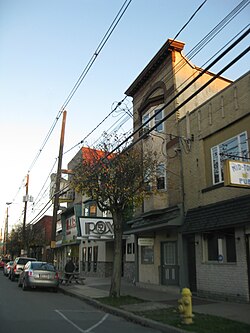Plymouth, PA
| Plymouth, Pennsylvania | |
|---|---|
| Borough | |

Downtown Plymouth
|
|
 Location of Plymouth in Luzerne County, Pennsylvania. |
|
| Location of Plymouth in Luzerne County, Pennsylvania. | |
| Coordinates: 41°14′31″N 75°56′53″W / 41.24194°N 75.94806°WCoordinates: 41°14′31″N 75°56′53″W / 41.24194°N 75.94806°W | |
| Country | United States |
| State | Pennsylvania |
| County | Luzerne |
| Settled | 1769 |
| Incorporated | 1866 |
| Government | |
| • Type | Borough Council |
| • Mayor | Dorothy Petrosky |
| Area | |
| • Total | 1.18 sq mi (3.07 km2) |
| • Land | 1.10 sq mi (2.84 km2) |
| • Water | 0.09 sq mi (0.22 km2) |
| Population (2010) | |
| • Total | 5,951 |
| • Estimate (2016) | 5,792 |
| • Density | 5,279.85/sq mi (2,037.93/km2) |
| Time zone | Eastern (EST) (UTC−5) |
| • Summer (DST) | EDT (UTC−4) |
| Zip code | 18651 |
| Area code(s) | 570 |
| FIPS code | 42-61648 |
Plymouth is a borough in Luzerne County, Pennsylvania, 4 miles (6 km) west of Wilkes-Barre (along the Susquehanna River). The population was 5,951 as of the 2010 census.
Plymouth was first settled in 1769 by the Susquehanna Company of Connecticut. It was originally part of Plymouth Township. The Pennamite-Yankee Wars were fought in the surrounding area.
Plymouth is situated in the rich hard coal fields of Pennsylvania. Coal was first shipped in 1807. Plymouth was incorporated as a borough in 1866. Elijah C. Wadhams served as the first mayor; he held office until 1869. In the past, the chief products of its industrial establishments included mining drilling machines, miners' squibs, silk hosiery, and lumber products. In 1910, its population peaked at 16,996.
At the beginning of the 19th century, Plymouth's primary industry was agriculture, and many of its residents were the descendants of the Connecticut Yankees (who first settled the town). Its early architecture resembled that of a small New England village. However, vast anthracite coal beds lay below the surface at various depths, and by the 1850s, coal mining was the town's primary occupation, attracting a more diverse population. After the arrival of the railroad (in 1857), the town's architecture became more typical of a growing industrial center.
According to the United States Census Bureau, the borough has a total area of 1.2 square miles (3.1 km2), of which 1.1 square miles (2.8 km2) is land and 0.08 square miles (0.2 km2), or 7.31%, is water.
1858 anthracite map
1864 map of Plymouth Township
1873 map of Plymouth
1884 aerial view of Plymouth
1884 mine map of Plymouth
...
Wikipedia

